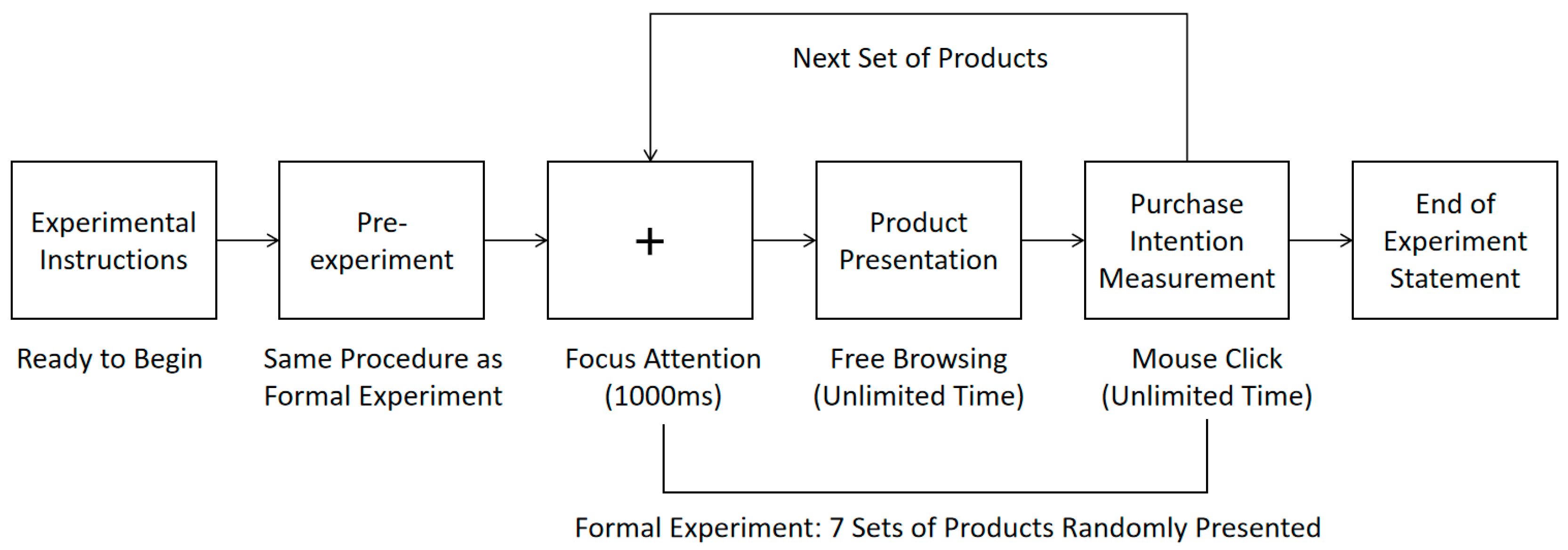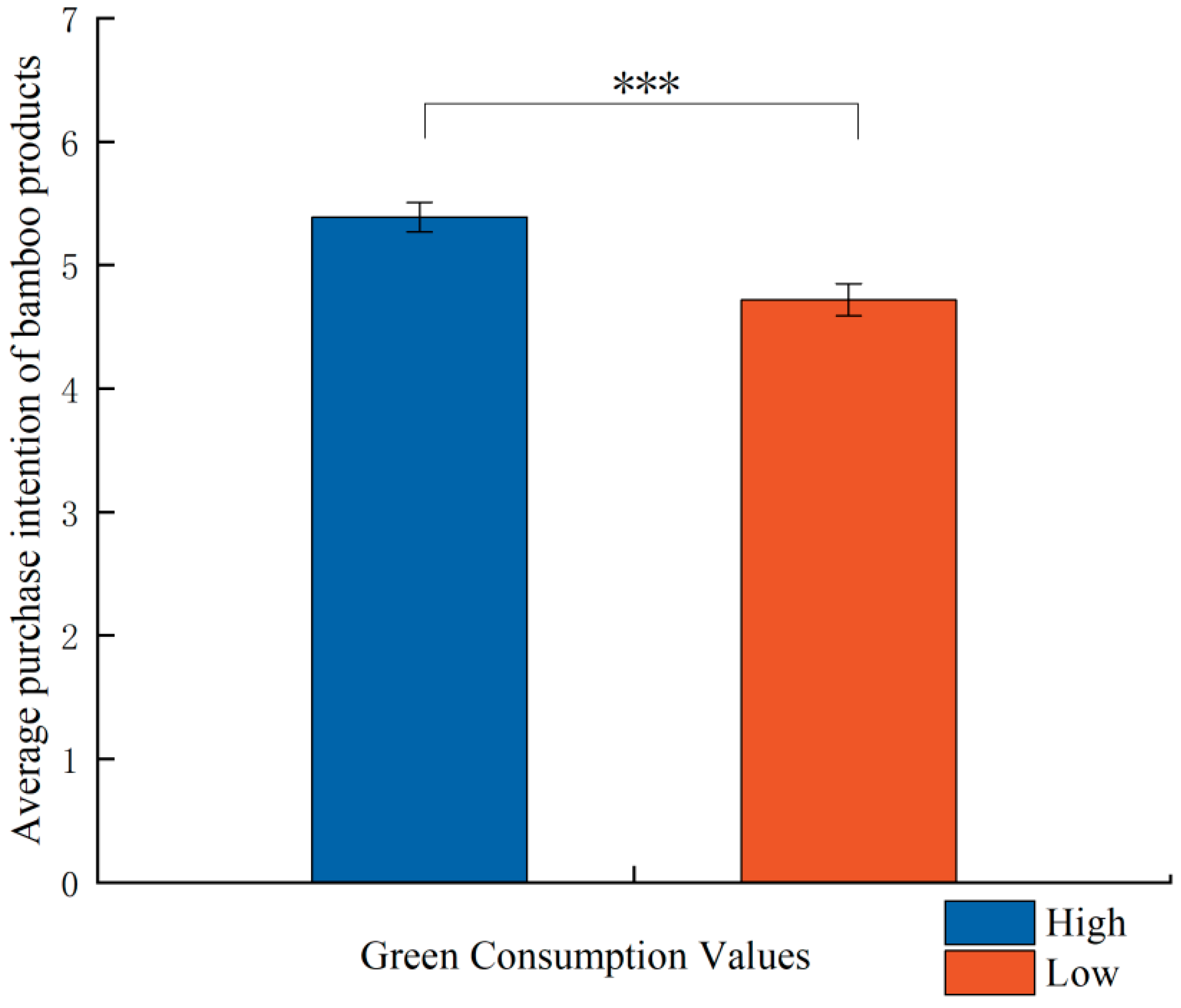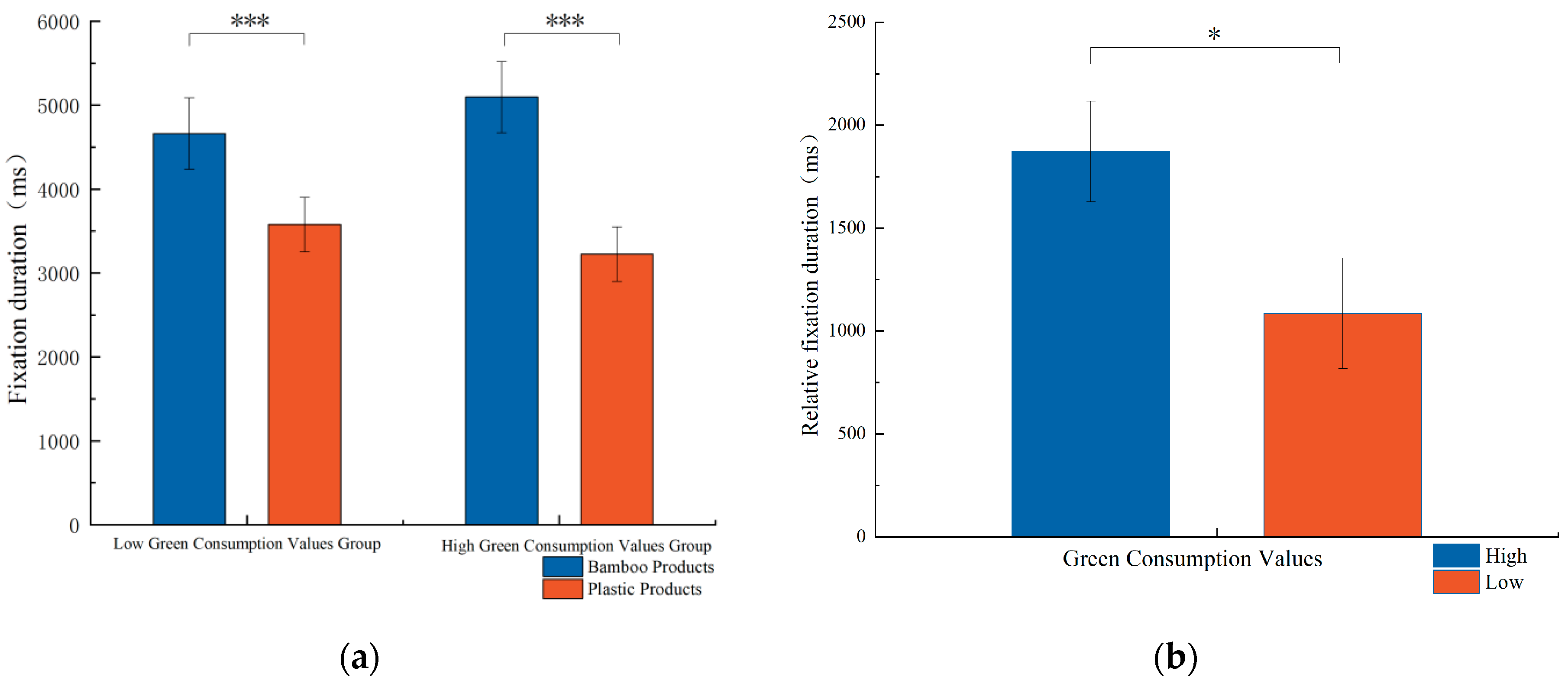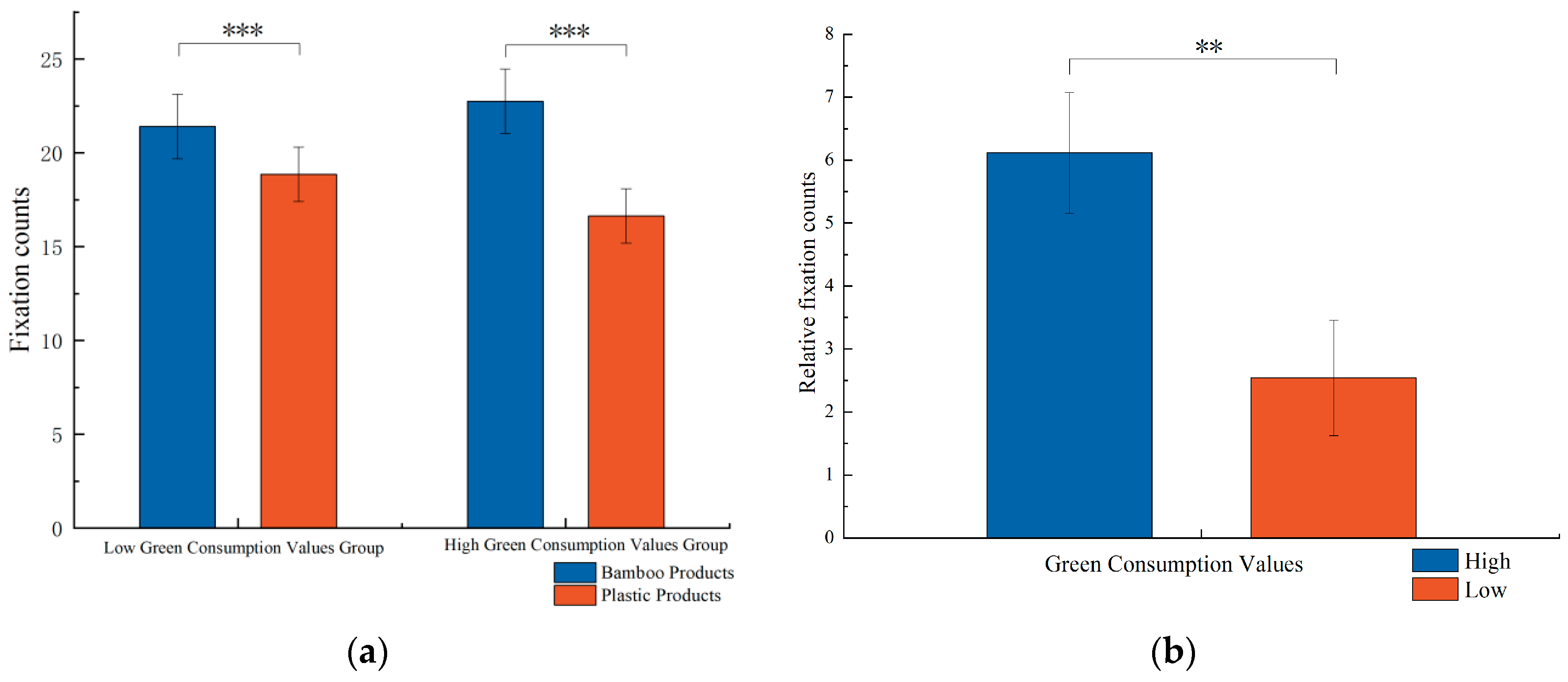An Eye-Tracking Study on the Impact of Green Consumption Values on the Purchase Intention of Bamboo Products Under the Background of “Replacing Plastic with Bamboo”
Abstract
1. Introduction
2. Literature Review and Hypothesis Development
2.1. Green Purchase Intention
2.2. Value–Belief–Norm Theory (VBN Theory)
2.3. Product Material and Purchase Intention
2.4. Green Consumption Values and Purchase Intention
2.5. Eye Movement and Cognitive Processing
3. Research Methodology
3.1. Participants
3.2. Experimental Materials
3.3. Experimental Design
- (a)
- Product material (within-subjects factor: bamboo vs. plastic)
- (b)
- Green consumption values (between-subjects factor: high vs. low, grouped based on questionnaire scores).
- (a)
- Behavioral level: Purchase intention (measured on a 7-point scale).
- (b)
- Cognitive level: Eye-tracking metrics (fixation duration, fixation count).
3.4. Experimental Equipment and Procedure
3.5. Data Processing
4. Results
4.1. Manipulation Check
4.2. Behavioral Data Analysis
4.3. Analysis of Visual Heatmaps
4.4. Fixation Duration
4.5. Fixation Counts
5. Discussion
5.1. The Impact of Product Material on Consumers’ Purchase Intention and Visual Attention Processing
5.2. The Impact of Green Consumption Values on Consumers’ Purchase Intention and Visual Attention Processing
6. Conclusions
7. Theoretical Contributions and Practical Implications
7.1. Theoretical Contributions
7.2. Practical Implications
8. Limitation and Future Research
8.1. Limitation
8.2. Future Research
Author Contributions
Funding
Institutional Review Board Statement
Informed Consent Statement
Data Availability Statement
Conflicts of Interest
References
- Abbey, J. D., Meloy, M. G., Guide, V. D. R., Jr., & Atalay, S. (2015). Remanufactured products in closed-loop supply chains for consumer goods. Production and Operations Management, 24(3), 488–503. [Google Scholar] [CrossRef]
- Alamerew, A. N., Zhu, Z., Kozak, R., Shrestha, A. K., Agdew, S., & Wang, G. (2025). Exploring the shift to bamboo alternatives: A Case Study on wood and plastic replacement in Ethiopia. Journal of Cleaner Production, 486, 144507. [Google Scholar] [CrossRef]
- ASEAN. (2021). ASEAN regional action plan for combating marine debris. Available online: https://asean.org/wp-content/uploads/2021/05/FINAL_210524-ASEAN-Regional-Action-Plan_Ready-to-Publish_v2.pdf (accessed on 14 July 2025).
- Baek, K. (2024). Understanding the eco-friendly decision-making process of meal kit consumers based on the value-belief-norm (VBN) model: The mediating role of anticipated guilt and pride. The Tourism Sciences Society of Korea, 48, 101–119. [Google Scholar] [CrossRef]
- Basiru, I., Xu, Y., Arkorful, V. E., Lugu, B. K., & Ibrahim, A. H. (2024). Energy efficiency labels and urban residents’ intention to purchase energy-efficient household appliances: An empirical study based on the theory of planned behavior. Clean Technologies and Environmental Policy, 1–16. [Google Scholar] [CrossRef]
- Bezin, E. (2019). The economics of green consumption, cultural transmission and sustainable technological change. Journal of Economic Theory, 181, 497–546. [Google Scholar] [CrossRef]
- Bogomolova, S., Oppewal, H., Cohen, J., & Yao, J. (2020). How the layout of a unit price label affects eye-movements and product choice: An eye-tracking investigation. Journal of Business Research, 111, 102–116. [Google Scholar] [CrossRef]
- Carfora, V., Cavallo, C., Catellani, P., Del Giudice, T., & Cicia, G. (2021). Why do consumers intend to purchase natural food? Integrating theory of planned behavior, value-belief-norm theory, and trust. Nutrients, 13(6), 1904. [Google Scholar] [CrossRef]
- Chang, F.-C., Chen, K.-S., Yang, P.-Y., & Ko, C.-H. (2018). Environmental benefit of utilizing bamboo material based on life cycle assessment. Journal of Cleaner Production, 204, 60–69. [Google Scholar] [CrossRef]
- Chen, M., & Zhang, Z. (2015). Material emotion research on green product design. Furniture & Interior Design, 2015(1), 58–59. [Google Scholar] [CrossRef]
- China National Development and Reform Commission & China Ministry of Ecology and Environment. (2020). Opinions on further strengthening plastic pollution control. Available online: https://www.gov.cn/zhengce/zhengceku/2020-01/20/content_5470895.htm (accessed on 14 July 2025).
- China National Development and Reform Commission, Ministry of Industry and Information Technology, Ministry of Finance & National Forestry and Grassland Administration. (2023). Three-year action plan to accelerate the development of bamboo substitution for plastic. Available online: https://www.gov.cn/zhengce/zhengceku/202311/content_6913316.htm (accessed on 14 July 2025).
- EU. (2019). Directive on the reduction of the impact of certain plastic products on the environment. Available online: https://eur-lex.europa.eu/eli/dir/2019/904/oj (accessed on 14 July 2025).
- Faul, F., Erdfelder, E., Lang, A.-G., & Buchner, A. (2007). G* Power 3: A flexible statistical power analysis program for the social, behavioral, and biomedical sciences. Behavior Research Methods, 39(2), 175–191. [Google Scholar] [CrossRef]
- Guyader, H., Ottosson, M., & Witell, L. (2017). You can’t buy what you can’t see: Retailer practices to increase the green premium. Journal of Retailing and Consumer Services, 34, 319–325. [Google Scholar] [CrossRef]
- Halton, C., Duane, B., Batey, A. C., Wong, J., Corley, A., Hart, F., Koh, J., & Johnston, B. (2022). How much do consumers consider sustainability when purchasing a toothbrush? A discrete choice experiment. British Dental Journal, 233(4), 327–332. [Google Scholar] [CrossRef]
- Haws, K. L., Winterich, K. P., & Naylor, R. W. (2014). Seeing the world through GREEN-tinted glasses: Green consumption values and responses to environmentally friendly products. Journal of Consumer Psychology, 24(3), 336–354. [Google Scholar] [CrossRef]
- Hu, H., Wang, C., & Chen, M. (2024). The influence of a regional public brand on consumers’ purchase intention and behavior toward eco-agricultural products: A Chinese national park case. Sustainability, 16(21), 9253. [Google Scholar] [CrossRef]
- Janiszewski, C., Kuo, A., & Tavassoli, N. T. (2013). The influence of selective attention and inattention to products on subsequent choice. Journal of Consumer Research, 39(6), 1258–1274. [Google Scholar] [CrossRef]
- Jebarajakirthy, C., Sivapalan, A., Das, M., Maseeh, H. I., Ashaduzzaman, M., Strong, C., & Sangroya, D. (2024). A meta-analytic integration of the theory of planned behavior and the value-belief-norm model to predict green consumption. European Journal of Marketing, 58(4), 1141–1174. [Google Scholar] [CrossRef]
- Jiang, Z., Liu, N., Zhang, X., Chu, Y., & Zhang, L. (2025). Proactive social learning and green product consumption: Evidence from new energy vehicle sales in China. Technological Forecasting and Social Change, 219, 124232. [Google Scholar] [CrossRef]
- Just, M. A., & Carpenter, P. A. (1980). A theory of reading: From eye fixations to comprehension. Psychological Review, 87(4), 329. [Google Scholar] [CrossRef]
- Kline, P. (2013). Handbook of psychological testing. Routledge. [Google Scholar]
- Lao, W., Hu, J., Huang, Y., & Li, X. (2025). Environmental footprints of wood and bamboo reconstituted materials production in China: A cradle-to-gate life cycle assessment. Industrial Crops and Products, 232, 121320. [Google Scholar] [CrossRef]
- Lee, S. S., Kim, Y., & Roh, T. (2023). Pro-environmental behavior on electric vehicle use intention: Integrating value-belief-norm theory and theory of planned behavior. Journal of Cleaner Production, 418, 138211. [Google Scholar] [CrossRef]
- Lei, J., Zhang, J., Zhang, W., Zhu, L., Yuan, S., Wu, A., & Wang, J. (2024). Development of machinery and equipment for the processing of fast-moving consumer bamboo goods. World Forestry Research, 37(1), 83–89. [Google Scholar]
- Levin, G. (1990). Consumers turning green: JWT survey. Advertising Age, 61(47), 61–74. [Google Scholar]
- Lin, S., Zhang, H., Yang, Q., Ding, Y., Xie, J., Cao, F., & Jiang, J. (2025). The development advantages of “bamboo as a substitute for plastic” and the challenges faced in the efficient cultivation of bamboo resources. Journal of Nanjing Forestry University (Natural Sciences Edition), 49(4), 1–11. [Google Scholar] [CrossRef]
- Ling, Y., Xu, J., & Zhang, H. (2021). Vertical differentiation design and pricing strategy of green products based on heterogeneous consumer preference. Journal of Industrial Engineering and Engineering Management, 35(6), 208–217. [Google Scholar]
- Liu, X., Kim, T.-H., & Lee, M.-J. (2025). The impact of green perceived value through green new products on purchase intention: Brand attitudes, brand trust, and digital customer engagement. Sustainability, 17(9), 4106. [Google Scholar] [CrossRef]
- Liu, Z., & Hu, R. (2022). Study on the influencing factors of consumers’ green consumption behavior: From the e-commerce environment perspective. Ecological Economy, 38(8), 60–67. [Google Scholar]
- Lohse, G. L. (1997). Consumer eye movement patterns on yellow pages advertising. Journal of Advertising, 26(1), 61–73. [Google Scholar] [CrossRef]
- Luan, X., Ma, D., Xia, L., & Wu, l. (2020). The influence of perceived quality of the green agricultural product on consumer’s purchase intention. Price: Theory & Practice, 2020(12), 103–106+163. [Google Scholar] [CrossRef]
- Macht, J., Klink-Lehmann, J., & Venghaus, S. (2023). Eco-friendly alternatives to food packed in plastics: German consumers’ purchase intentions for different bio-based packaging strategies. Food Quality and Preference, 109, 104884. [Google Scholar] [CrossRef]
- Najafabadiha, A., Wang, Y., Gholizadeh, A., Javanmardi, E., & Zameer, H. (2025). Fostering consumer engagement in online shopping: Assessment of environmental video messages in driving purchase intentions toward green products. Journal of Environmental Management, 373, 123637. [Google Scholar] [CrossRef]
- Ollitervo, V., Sipilä, J., & Terho, H. (2025). The package says more than a thousand words: The effect of eco-labelling and package material on consumer’s purchase intentions. Journal of Consumer Behaviour, 24(3), 1421–1440. [Google Scholar] [CrossRef]
- Orquin, J. L., & Loose, S. M. (2013). Attention and choice: A review on eye movements in decision making. Acta Psychologica, 144(1), 190–206. [Google Scholar] [CrossRef]
- Pegan, G., Marzi, G., & Ranfagni, S. (2025). Pathways to sustainable consumption apps adoption: Extending UTAUT2 with personal values and behaviors. Business Strategy and the Environment. [Google Scholar] [CrossRef]
- Pieters, R., & Warlop, L. (1999). Visual attention during brand choice: The impact of time pressure and task motivation. International Journal of research in Marketing, 16(1), 1–16. [Google Scholar] [CrossRef]
- Rai, A., Patyal, V. S., & Ambekar, S. (2025). Women as catalysts: Eco-literacy and adoption of energy-efficient appliances for a sustainable lifestyle. Energy Policy, 203, 114650. [Google Scholar] [CrossRef]
- Rehman, A., Manzoor, S. R., Ullah, A., Han, H., Ariza-Montes, A., & Gil-Marín, M. (2025). Eco-driven choices: Green marketing orientation intervention toward green purchase intention in the home appliances industry. Acta Psychologica, 258, 105125. [Google Scholar] [CrossRef]
- Ribeiro, M. A., Seyfi, S., Elhoushy, S., Woosnam, K. M., & Patwardhan, V. (2025). Determinants of generation Z pro-environmental travel behaviour: The moderating role of green consumption values. Journal of Sustainable Tourism, 33(6), 1079–1099. [Google Scholar] [CrossRef]
- Sheng, G., Gong, S., & Xie, F. (2019). Theoretical basis and empirical test of the formation of Chinese consumers’ green purchasing intention. Jilin University Journal of Humanities and Social Sciences, 59(1), 140–151+222. [Google Scholar]
- Sovbetov, I. (2025). Carbon footprint embodied in global fiber trades. Journal of Natural Fibers, 22(1), 2503970. [Google Scholar] [CrossRef]
- Srivastava, S. K. (2007). Green supply-chain management: A state-of-the-art literature review. International Journal of Management Reviews, 9(1), 53–80. [Google Scholar] [CrossRef]
- Steg, L., Dreijerink, L., & Abrahamse, W. (2005). Factors influencing the acceptability of energy policies: A test of VBN theory. Journal of Environmental Psychology, 25(4), 415–425. [Google Scholar] [CrossRef]
- Steinhauser, J., Janssen, M., & Hamm, U. (2019). Consumers’ purchase decisions for products with nutrition and health claims: What role do product category and gaze duration on claims play? Appetite, 141, 104337. [Google Scholar] [CrossRef]
- Stren, P. (2000). Toward a coherent theory of environmentally significant behaviour. Journal of Social Issues, 56(3), 407–424. [Google Scholar] [CrossRef]
- Sun, L. (2023). Analysis of consumer product authenticity perception and agricultural product marketing under green constraints. Journal of Commercial Economics, 2023(21), 126–130. [Google Scholar] [CrossRef]
- Tan, C. N.-L., Fauzi, M. A., & Harun, S. A. B. (2025). From perceived green product quality to purchase intention: The roles of price sensitivity and environmental concern. Marketing Intelligence & Planning. [Google Scholar] [CrossRef]
- Thwe, S. M., Lim, W. M., Koay, K. Y., & Ong, D. (2025). Consumers’ motivation to purchase electric vehicles: A mixed-methods belief elicitation study using theory of planned behavior. Acta Psychologica, 258, 105185. [Google Scholar] [CrossRef]
- UNEP. (2021). From pollution to solution: A global assessment of marine litter and plastic pollution. Available online: https://www.unep.org/resources/pollution-solution-global-assessment-marine-litter-and-plastic-pollution (accessed on 14 July 2025).
- Varshneya, G., Pandey, S. K., & Das, G. (2017). Impact of social influence and green consumption values on purchase intention of organic clothing: A study on collectivist developing economy. Global Business Review, 18(2), 478–492. [Google Scholar] [CrossRef]
- Vogtländer, J., Van der Lugt, P., & Brezet, H. (2010). The sustainability of bamboo products for local and Western European applications. LCAs and land-use. Journal of Cleaner Production, 18(13), 1260–1269. [Google Scholar] [CrossRef]
- Wan, D., Shen, P., & Zhu, A. (2024). Impact of AI-driven perceptions of environmental benefits of products on consumer purchase intentions—Based on the illusion of control theory. Journal of Beijing Technology and Business University (Social Sciences), 39(3), 15–27. [Google Scholar]
- Wang, B., An, S., & Li, K. (2025). Shaping green choices: How sensory cues drive behavior of wood-plastic composites. Behavioral Sciences, 15(3), 383. [Google Scholar] [CrossRef] [PubMed]
- Wang, C. (2019). Who would prefer to buy green products? Understanding green consumers. Journal of Psychological Science, 42(6), 1416–1421. [Google Scholar]
- Wang, C. (2023). Dynamic or static? The effect of background presentation of product images on consumers’ purchase intention based on behavioral and eye tracking experiments. Jinan Journal (Philosophy & Social Sciences), 45(8), 72–85. [Google Scholar]
- Wang, C., Chen, X., Zhu, W., Fu, W., & Jin, J. (2020). Eye-tracking study on the impact of photographic reviews and verbal reviews on consumers’ perceived usefulness. Information Studies: Theory & Application, 43(6), 135–141. [Google Scholar]
- Wang, H., Shi, R., Liu, C., Jia, X., Wang, M., & Wei, B. (2023). Eye movement study for the influence of food packaging materials on consumers’ green purchase intention. Packaging Engineering, 44(13), 55–62. [Google Scholar]
- Wang, J., Wang, J., & Gao, J. (2020). Effect of green consumption value on consumption intention in a pro-environmental setting: The mediating role of approach and avoidance motivation. Sage Open, 10(1), 2158244020902074. [Google Scholar] [CrossRef]
- Wattoo, M. U., Du, J., Zhou, J., Jose, S., & Piccardi, P. (2025). Exploring green purchase behavior in online agricultural markets: A multi-phase consumer decision model. British Food Journal, 127(9), 3361–3380. [Google Scholar] [CrossRef]
- Witek, L., & Kuźniar, W. (2020). Green purchase behavior: The effectiveness of sociodemographic variables for explaining green purchases in emerging market. Sustainability, 13(1), 209. [Google Scholar] [CrossRef]
- Wu, B., & Yang, Z. (2018). The impact of moral identity on consumers’ green consumption tendency: The role of perceived responsibility for environmental damage. Journal of Environmental Psychology, 59, 74–84. [Google Scholar] [CrossRef]
- Xie, C., Wang, R., & Gong, X. (2022). The influence of environmental cognition on green consumption behavior. Frontiers in Psychology, 13, 988585. [Google Scholar] [CrossRef]
- Xue, Y., Abd Rahman, K. A. A., Ariffin, N. F. B. M., & Ali, N. A. B. M. (2024). Research on the relationship between bamboo-based product design attributes and consumer satisfaction. Forest Products Journal, 74(1), 44–53. [Google Scholar] [CrossRef]
- Yan, L., Keh, H. T., & Wang, X. (2021). Powering sustainable consumption: The roles of green consumption values and power distance belief. Journal of Business Ethics, 169(3), 499–516. [Google Scholar] [CrossRef]
- Yang, J., Wang, D., Song, J., & Hu, Z. (2019). Study on the influence mechanism of green dwellings purchase willingness considering information asymmetry. Ecological Economy, 35(10), 74–79+85. [Google Scholar]
- Yao, F. (2023). How to arrange assortments available in green alternatives: Displaying products by green attributes. Journal of Consumer Behaviour, 22(4), 867–879. [Google Scholar] [CrossRef]
- Ye, H., Fu, J., Cheng, H., Chen, F., Yang, S., & Wang, G. (2024). The current status and market development potential of processing technology and products using bamboo as a substitute for plastic. Scientia Silvae Sinicae, 60(1), 129–141. [Google Scholar]
- Yu, C., Zhu, X., Wang, X., & Zhang, Y. (2019). Face consciousness and green buying intention: The moderating effect of consumption context and mediating effect of price. Management Review, 31(11), 139–146. [Google Scholar]
- Zhang, J., Chen, L., Wang, T., & Yu, S. (2024). Brief analysis on the main contents for industry plan organizing of replacing plastic with bamboo. China Forest Products Industry, 61(8), 76–81+92. [Google Scholar]
- Zhang, M., Zhou, G., Gu, L., & Wang, W. (2024). Grading of products utilizing bamboo as a substitute for plastic based on environmental effects. Scientia Sinica (Terrae), 54(9), 3040–3050. [Google Scholar] [CrossRef]
- Zhang, W., Cui, B., Sun, L., & Li, S. (2022). “Green” packaging design of coating products based on eye tracking technology. Experimental Technology and Management, 39(6), 56–61. [Google Scholar]
- Zheng, S., Lyu, X., Wang, J., & Wachenheim, C. (2023). Enhancing sales of green agricultural products through live streaming in China: What affects purchase intention? Sustainability, 15(7), 5858. [Google Scholar] [CrossRef]
- Zheng, Z., Srinuan, C., & Rojniruttikul, N. (2025). Exploring the impact of digital platform on energy-efficient consumption behavior: A multi-group analysis of air conditioning purchase in China using the extended TPB Model. Sustainability, 17(11), 5192. [Google Scholar] [CrossRef]
- Zhou, J., Wei, F., Fei, K., & Yan, Z. (2022). A review on residents’ green consumption research. Journal of Zhejiang University (Humanities and Social Sciences), 52(9), 57–68. [Google Scholar]




| Category | Experimental Material Samples | ||||||
|---|---|---|---|---|---|---|---|
| Product Number | 1 | 2 | 3 | 4 | 5 | 6 | 7 |
| Product Category | Bamboo Shell | Bamboo Stationery | Bamboo Personal Care Products | Bamboo Furniture | Disposable Bamboo Tableware | Durable Bamboo Catering Utensils | Bamboo Degradable Bags |
| Bamboo Products |  |  |  |  |  |  |  |
| Plastic Products |  |  |  |  |  |  |  |
| Price (CNY) | 100 | 50 | 10 | 10 | 0.5 | 5 | 1 |
| Material | Material 1 | Material 2 | Material 3 | Material 4 | Material 5 | Material 6 | Material 7 |
|---|---|---|---|---|---|---|---|
| Bamboo |  |  |  |  |  |  |  |
| Plastic |  |  |  |  |  |  |  |
Disclaimer/Publisher’s Note: The statements, opinions and data contained in all publications are solely those of the individual author(s) and contributor(s) and not of MDPI and/or the editor(s). MDPI and/or the editor(s) disclaim responsibility for any injury to people or property resulting from any ideas, methods, instructions or products referred to in the content. |
© 2025 by the authors. Licensee MDPI, Basel, Switzerland. This article is an open access article distributed under the terms and conditions of the Creative Commons Attribution (CC BY) license (https://creativecommons.org/licenses/by/4.0/).
Share and Cite
Shi, R.; Qiao, T.; Liu, C.; Chen, Z. An Eye-Tracking Study on the Impact of Green Consumption Values on the Purchase Intention of Bamboo Products Under the Background of “Replacing Plastic with Bamboo”. Behav. Sci. 2025, 15, 1162. https://doi.org/10.3390/bs15091162
Shi R, Qiao T, Liu C, Chen Z. An Eye-Tracking Study on the Impact of Green Consumption Values on the Purchase Intention of Bamboo Products Under the Background of “Replacing Plastic with Bamboo”. Behavioral Sciences. 2025; 15(9):1162. https://doi.org/10.3390/bs15091162
Chicago/Turabian StyleShi, Rui, Tongjia Qiao, Chang Liu, and Ziyu Chen. 2025. "An Eye-Tracking Study on the Impact of Green Consumption Values on the Purchase Intention of Bamboo Products Under the Background of “Replacing Plastic with Bamboo”" Behavioral Sciences 15, no. 9: 1162. https://doi.org/10.3390/bs15091162
APA StyleShi, R., Qiao, T., Liu, C., & Chen, Z. (2025). An Eye-Tracking Study on the Impact of Green Consumption Values on the Purchase Intention of Bamboo Products Under the Background of “Replacing Plastic with Bamboo”. Behavioral Sciences, 15(9), 1162. https://doi.org/10.3390/bs15091162








